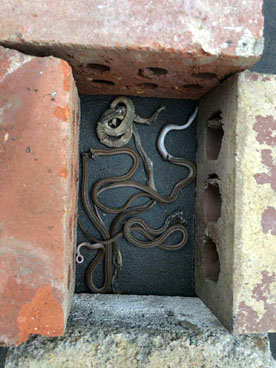
Copperhead snakes are common in the southern states.
Dealing with venomous snakes in crawl spaces is all too common for spray foam companies in the south. Snakes can get into the smallest cracks, gaps and holes so these areas should be tightly sealed. Some people use caulk for patching; however, caulk breaks down over time, and it may be difficult to fully apply it in hard-to-reach areas. Spray foam is a better option for thorough sealing and a long-lasting fix. Spray foam’s expanding capability gets the foam into the smallest cracks and other places where sealing is needed.
Homeowners can take steps to deter snakes around their homes by removing the snake’s food sources. Bird seed, spilled from bird feeders, attracts mice and rodents which are a food source for snakes. Mulch can provide a moist habitat as well as a food source for snakes because it attracts insects and other small creatures. Raking up piles of mulch will help deter snakes. Some homeowners use moth balls to rid themselves of snakes; however, this has not been scientifically proven to be effective.
One means of capturing snakes in crawl spaces, under porches, decks and other hard-to-reach areas, is to use a glue board. Once the snake is trapped, use a shovel to remove the glue board, with the entrapped snake, and move it far away from the home. Pouring vegetable oil over the glue board can allow the snake to free itself. It may seem counterintuitive to free the snake, but snakes perform a good service by eating mice rodents and insects.
Snake handling equipment, such as snake tongs (for smaller snakes), snake hooks (for larger snakes) and a strike-proof snake sack to hold the snakes can be used. It is advisable; however, to have training for this type of practice and know how to identify various snake species. When in doubt, call a professional.
Working in Crawl Spaces is not for the Faint of Heart
Unfortunately, most homeowners are unaware that snakes are lurking in their crawl spaces; therefore, the companies that work in those spaces often get a nasty surprise. While snakes are good at ridding us of mice, rodents and insects, the venomous ones can pose a problem for those who work in dark, damp crawl spaces. While professional extermination services, snake traps and an array of deterrent products are available, it takes time to make this happen. Crawl space workers often don’t have time to wait out a snake; however, unless you’re an experienced snake handler, it may be in everyone’s best interest to contact a professional exterminator and have the snakes removed before doing any work.
Be Prepared
Home inspection organizations recommend wearing knee pads, gloves, a Tyvek suit, goggles, a hard hat, a respirator with a HEPA filter and carrying a flashlight and cell phone with you. Snakes and other critters can bite through bags and Tyvek suit, so wearing a hazmat suit may be a better option. Keep in mind that some snakes can bite through leather, canvas and heavy denim. The highest number of snake bites generally occur on the hands and arms. Good lighting for crawl spaces is essential. This way, an inspection of the crawl space can be done to assess potential concerns, such as structural integrity, leaks, electrical wiring, chemicals, animal droppings and critters.
What to Do in Case of a Snake Bite
In the event of a snake bite, apply pressure to the area and an immobilization bandage. Stay calm and still as much as possible. Getting over excited will cause blood to flow through the body more quickly, making the problem worse. Do not wash the bite area or apply ice. Any venom residue left on the skin can help medical personnel identify the snake species. Do not apply a tourniquet, cut into the wound or try to suck out the venom. The human mouth is full of germs that can cause infection. Time means everything. Call 911 or your local emergency number and get help immediately. It’s always better to be safe than sorry. Crawl space workers deserve out utmost respect. It’s a dirty and potentially dangerous job, often with many risks.





